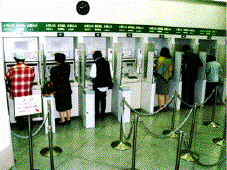 Science & Technology || Search || Back Numbers TELLERLESS BANKING:
 People are doing more of their banking in branches like this. (Photo: Kyodo) Banking services are undergoing a major transformation. The number of unstaffed branches with only automated teller machines has risen rapidly, and an increasing number of customer services are available over the telephone and on the Internet. The trend is the product of a matching of needs; customers seek greater convenience, and banks want to cut costs. With the Japanese "Big Bang" of financial deregulation set to be completed by early next century, banking services should further diversify in the months ahead.
Unstaffed Branches
Of the 10 city banks, only 2 had more staffed branches than tellerless ones (52% versus 48% for both), and at one city bank, 66% of its branches were unstaffed. The principal factor behind the increase in ATM-only branches is banks' desire to downsize their work force while expanding their sales network. Because ATM outlets do not have to comply with standards that normally need be met when establishing branches, they can be easily set up in strategic locations and moved without much hassle. Users also benefit from having access to terminals at convenient locations. Most services banks offer are now available on ATMs, and bank spokespersons claim that even among those who visit branches with tellers, 80% do all their transactions on ATMs. The services ATMs handle are growing, moreover. One city bank has installed "multimedia" terminals at a tellerless branch in Tokyo that enable users to open a savings account. Even nonbanking services are being provided; people can apply for credit cards and purchase goods from these machines.
Home Banking
By registering with the bank, depositors can use push-button phones to transfer money from one account to another, set up time deposits, and check the balance in their accounts. About the only functions that can be performed on ATMs but not over the phone are deposits and withdrawals of cash. Some city banks initiated a service allowing depositors with personal computers to access the banks' computer networks. By using communications software provided by the bank, users could check how much they had in their accounts and make cash transfers on PC screens. The latest convenience is banking on the Internet. A Kansai-based city bank was the first to offer this service in January this year. By accessing the bank's Website, depositors can make transfers to preregistered accounts and check their balances. A bank official explained that this service has been extremely well received, since it allows users to transfer money even when they are too busy to leave the house or office. By this fall, all city banks are expected to offer banking on the Web. How widely Internet banking spreads, though, will hinge on the development of an electronic settlement system allowing users to pay for goods purchased over the Internet. One bank has asked its employees to serve as monitors for an experimental system to iron out problem areas before making it commercially available. As deregulation proceeds in the financial industry, standards covering the establishment of branches are expected to be relaxed. The Japanese "Big Bang" of sweeping financial reforms expected to be implemented by 2001, moreover, will further break down barriers between different financial services, such as banking, securities, and insurance. Banks will then be able to offer customers the option of investing in investment trusts, and competition in the financial sector should intensify. The wider variety of banking services now being offered are probably in anticipation of the upcoming financial explosion.
 Edited by Japan Echo Inc. based on domestic Japanese news sources. Articles presented here are offered for reference purposes and do not necessarily represent the policy or views of the Japanese Government.
Edited by Japan Echo Inc. based on domestic Japanese news sources. Articles presented here are offered for reference purposes and do not necessarily represent the policy or views of the Japanese Government.
|
